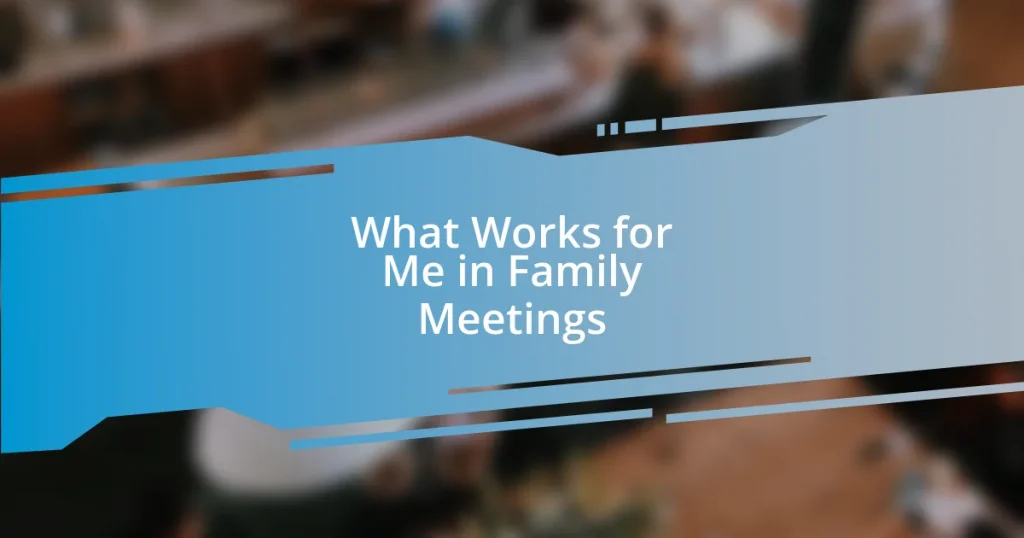Key takeaways:
- Family meetings enhance communication and connection, creating a safe space for family members to express their thoughts and feelings, ultimately fostering stronger bonds.
- Setting clear objectives and using structured agendas during meetings keeps discussions focused and encourages meaningful participation from all family members.
- Addressing conflicts constructively and following up on meeting outcomes promote accountability and shared responsibility, ensuring that family decisions are upheld and revisited.
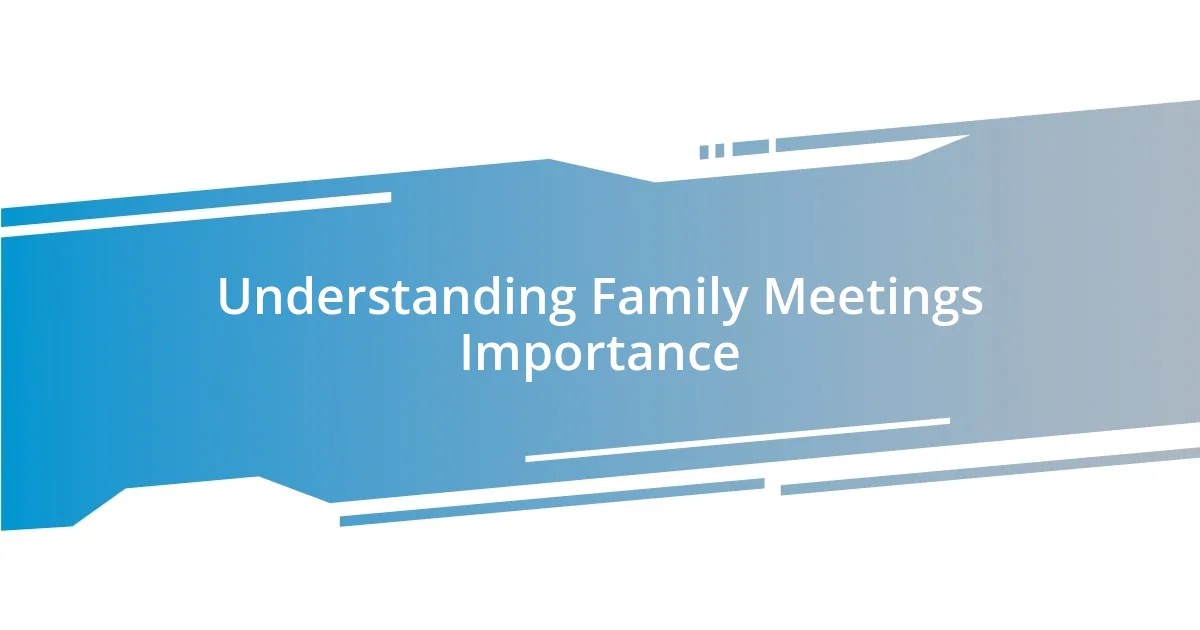
Understanding Family Meetings Importance
Family meetings play a crucial role in fostering open communication and connection among family members. I remember a time when my family was facing a particularly challenging decision about moving to a new city. Sitting down together, we shared our feelings, fears, and hopes. It was enlightening to see how everyone’s perspective shaped our final decision, reinforcing just how vital these gatherings can be.
Have you ever thought about how often misunderstandings arise within families? I know I have. Family meetings create a safe space for everyone to voice their thoughts, reducing the chances of conflict. For instance, after a few heartfelt discussions in our weekly meetings, we realized that my youngest sibling felt overlooked during homework time. Addressing it openly not only strengthened our bond but also made us more aware of each other’s needs.
Ultimately, the emotional importance of these meetings can’t be overstated. When we gather as a family, it’s more than just logistics; it’s about building love and trust. I cherish those moments when laughter and tears are shared, as they remind us that we’re all in this together, navigating life’s ups and downs as a united front. Isn’t it wonderful to think about how much stronger we can be through honest conversations?
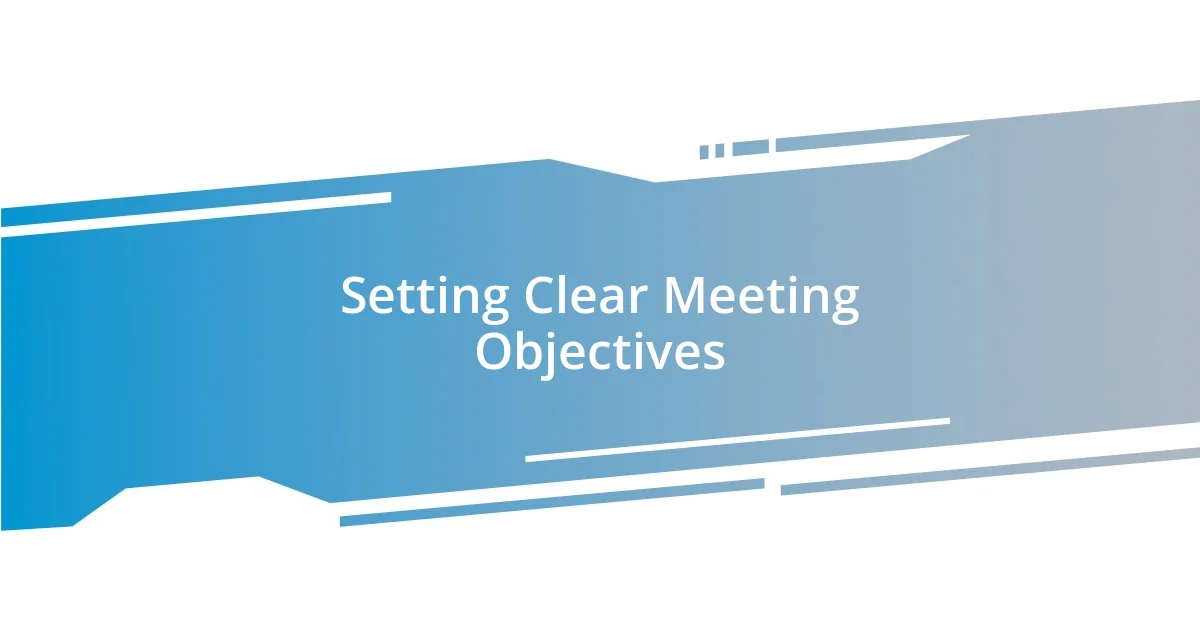
Setting Clear Meeting Objectives
Setting clear objectives for family meetings is essential to ensure everyone stays focused and engaged. I’ve found that outlining our goals at the start helps us avoid the common pitfalls of wandering off-topic. For example, during our last meeting, we aimed to discuss vacation plans specifically, and because we had that clarity, we managed to get everyone’s opinions and ideas without drifting into unrelated discussions.
Another aspect I appreciate is including everyone in the objective-setting process. In my experience, asking each family member what they hope to achieve during our meetings, whether it’s resolving an issue or simply sharing updates, fosters a sense of ownership. This was particularly evident when we worked on a project together; by defining our objectives collaboratively, each person felt their input was valued, leading to more productive and meaningful conversations.
Ultimately, the power of having clear meeting objectives can’t be understated. It not only sets the tone for the discussion but also enhances participation. I’ve noticed that when expectations are set, everyone enters the meeting with a common purpose. It’s amazing how this simple step transforms the dynamics, making it more deliberate and connected.
| Clarity in Objectives | Effects on Participation |
|---|---|
| Outlines what needs discussion | Encourages everyone to contribute |
| Reduces distractions | Enhances focus on the topic |
| Helps prioritize issues | Leads to efficient use of time |

Creating a Comfortable Atmosphere
Creating a comfortable atmosphere during family meetings is pivotal for encouraging open dialogue. I’ve learned that little touches can make a big difference. For instance, having a cozy setup, like sitting in our living room with snacks on hand, instantly makes everyone feel more relaxed. It’s amazing how something as simple as a comfortable chair can help ease tension and foster a welcoming space for discussion.
To further enhance this comfortable vibe, here are some practical tips that have worked for my family:
- Choose a familiar setting: Meeting in a place where everyone feels at ease can promote comfort and open-mindedness.
- Include personal touches: Displaying family photos or mementos can evoke positive emotions and spark connection among family members.
- Maintain a casual tone: Using light-hearted banter or humor can lighten the mood, making it easier for everyone to share their thoughts.
- Encourage participation: I invite each person to share what they love most about our family gatherings, creating a sense of belonging that loosens everyone up.
- Respect personal space: Arranging seating so everyone has a view and feels comfortable can help reduce any feelings of pressure.
When I integrate these elements, it feels less like a meeting and more like a gathering of friends, which ultimately paves the way for honest conversations and deeper connections.
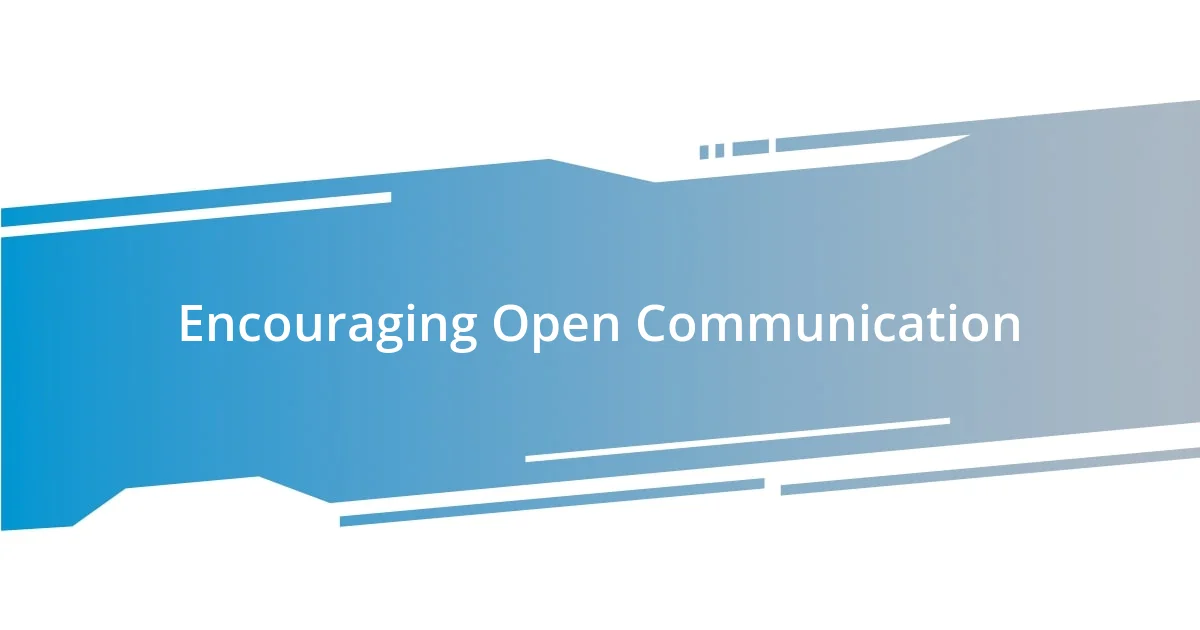
Encouraging Open Communication
Encouraging open communication in family meetings is something I prioritize, and I’ve found that actively listening is a big part of it. When someone speaks, I make it a point to show that I’m truly engaged. For example, during a recent discussion about our holiday plans, I nodded and asked follow-up questions about what my kids wanted to explore. It was clear that they felt valued, making them more receptive to sharing their own ideas and concerns.
I also believe in setting aside dedicated time where everyone has the floor without interruptions. I recall a time when my partner and I designated the first part of our meeting specifically for the kids to express their thoughts. That simple change led to some enlightening moments, revealing their desires and anxieties about school that we had never discussed. Why do we sometimes assume kids don’t have opinions on important family matters? Giving them the opportunity to voice what’s on their minds encourages a dynamic of respect and fosters deeper connections.
Additionally, sharing my own experiences and vulnerabilities can lighten the atmosphere and invite others to do the same. I once opened up about a personal challenge I faced at work, and it created a ripple effect. Suddenly, my family shared their own stories of struggle, turning the meeting into a safe space filled with trust. Isn’t it powerful how a little honesty can cultivate an environment where everyone feels safe to express their feelings? This mutual sharing not only strengthens our bond but also carves a path for authentic conversation.
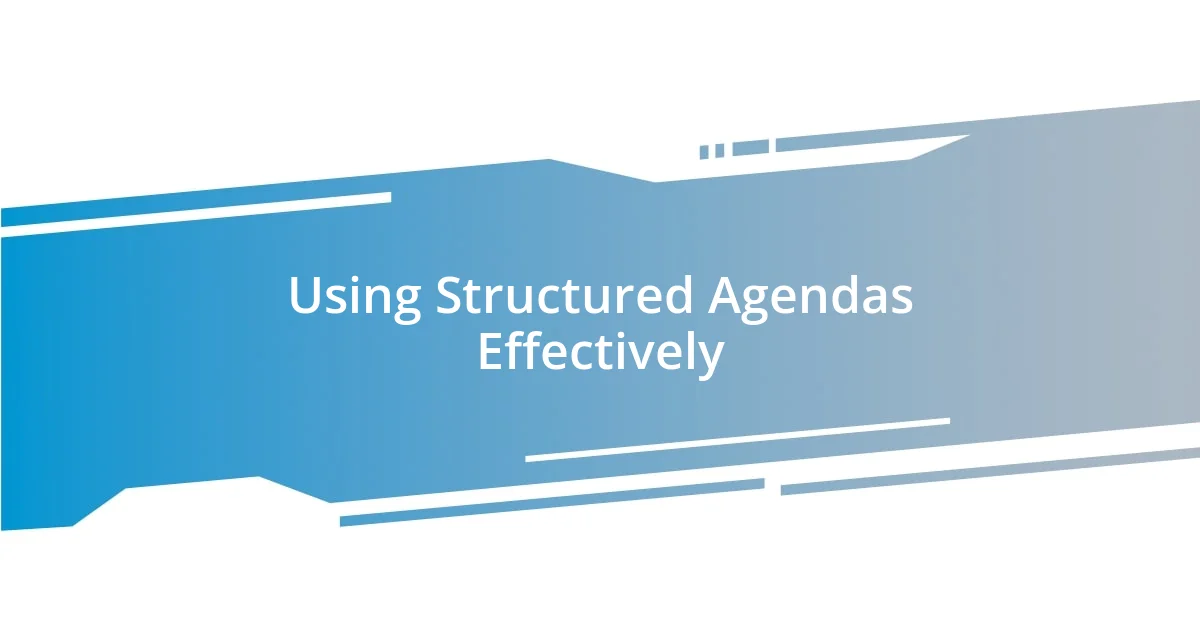
Using Structured Agendas Effectively
Using structured agendas has transformed our family meetings into focused and productive gatherings. I always start by sending out an outline before our meeting, allowing everyone to know what we’ll discuss. This preparation sets expectations and encourages family members to bring their thoughts, making the time we spend together more meaningful.
One time, I tried structuring our agenda around a shared family goal—saving for a vacation. I broke the discussion into sections: budgeting, activities, and responsibilities. This organization kept us on track and made sure we covered everything. It was eye-opening to see how engaged my family became when there was a clear purpose. Do you ever feel like conversations drift aimlessly? A well-structured agenda can serve as the compass that keeps everyone focused.
Additionally, I found that incorporating time limits for each topic is crucial. During one meeting where we discussed household chores, setting a timer helped us stay efficient. It not only prevented any one person from dominating the conversation but also encouraged everyone to express their opinions more quickly. How often do we linger on topics longer than necessary? By embracing structured agendas, I’ve witnessed how they not only streamline discussions but also foster participation and accountability among family members.
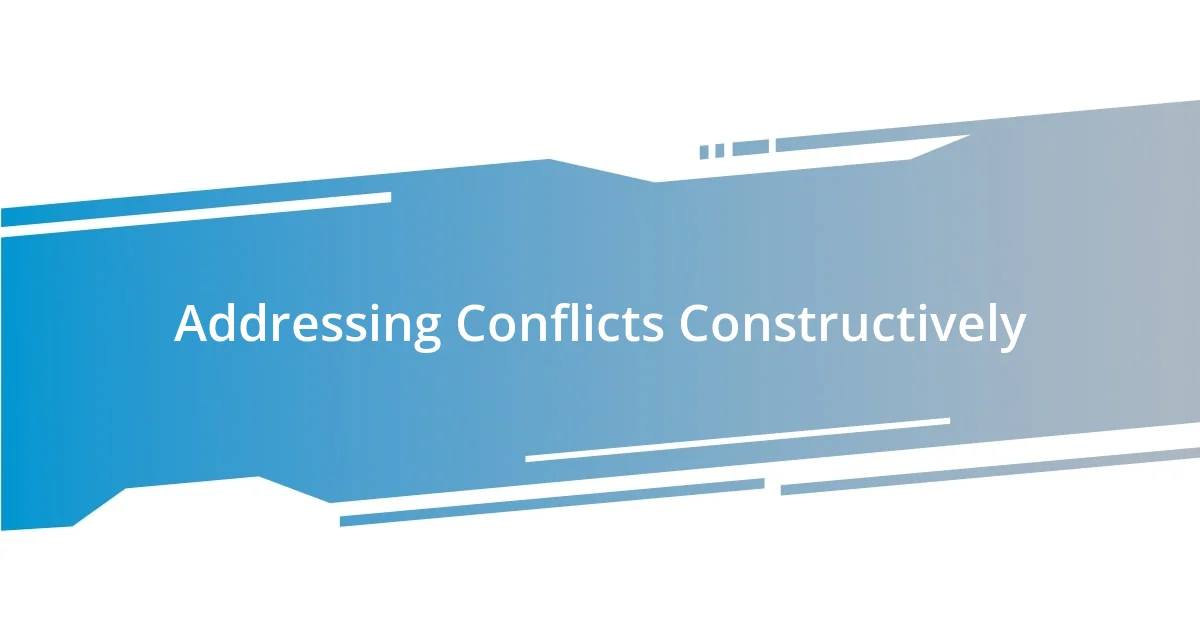
Addressing Conflicts Constructively
When conflicts arise during family meetings, I find it essential to approach them with a constructive mindset. I recall a heated discussion we had about screen time limits; tensions were rising. Instead of dismissing everyone’s emotions, I took a moment to acknowledge the frustrations we all felt. By validating their points of view, I noticed a shift in the atmosphere—everyone seemed more willing to talk rather than argue. Don’t you think recognizing feelings can change the dynamics of a disagreement?
I’ve learned that reframing conflicts as team challenges often leads to better solutions. For instance, when my teenagers expressed frustration over chores, I invited them to brainstorm ideas together. By shifting the narrative from “you have to do this” to “let’s figure this out as a team,” we not only resolved the immediate issue but also strengthened our collaboration and understanding of each other’s responsibilities. Isn’t it amazing how a simple change in wording can impact our family dynamic?
Moreover, I always strive to ensure that we end conflict discussions with clear action steps. After reaching a consensus in our screen time debate, I asked everyone to articulate what they could personally commit to for the upcoming week. This not only held us accountable but also allowed everyone to have a stake in the solution. Have you ever noticed how commitment fosters collective responsibility? It creates a shared purpose that binds us together, even when disagreements arise.
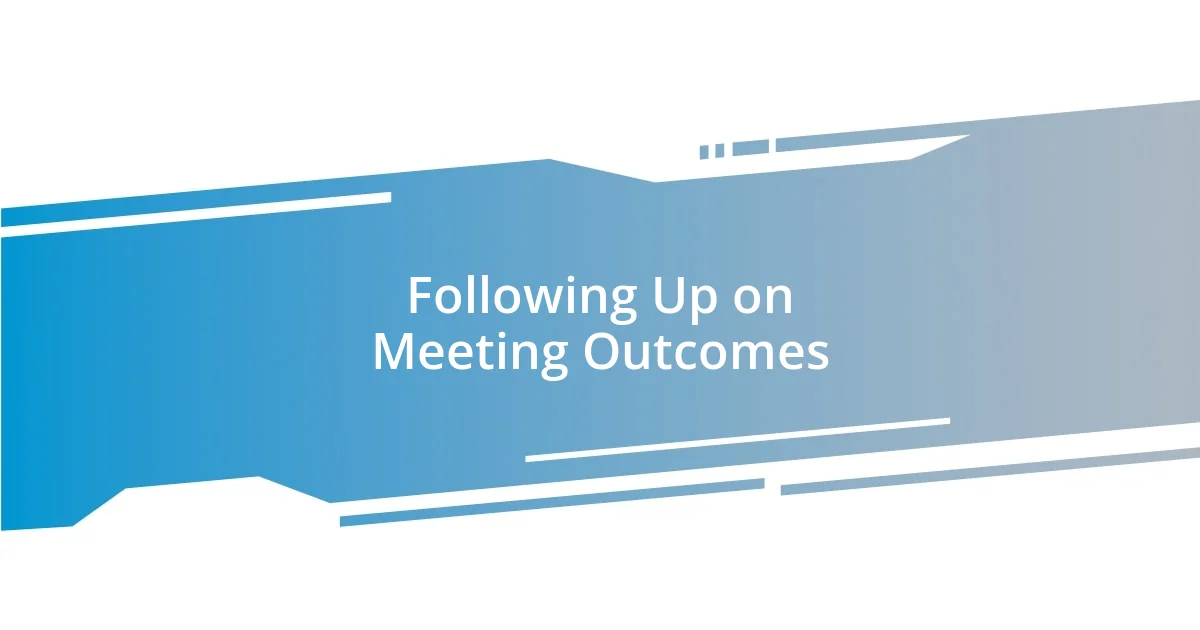
Following Up on Meeting Outcomes
Following up on the outcomes of family meetings is crucial for maintaining accountability. For example, after we agreed to implement a new schedule for family movie nights, I made it a point to check in regularly. I would casually ask, “How’s the schedule working for everyone?” This simple question not only keeps the commitment alive but also opens the door for feedback, allowing us to adjust if necessary.
I’ve also discovered that documenting decisions during meetings helps significantly in the follow-up process. After one discussion about household rules, I drafted a summary and shared it in our family group chat. Seeing those points pinned on a digital note reminded us of our promises. Don’t you find that a visual cue can really strengthen those commitments? It certainly has for us; it feels like we’re all on the same team, working towards common goals.
To ensure we’re on track, I like to revisit previous agendas during our next meeting. I bring up what we accomplished and what still needs our attention. For instance, when we planned to work on our garden, I highlighted what we achieved and what tasks were left. It sparks motivation and reinforces our shared responsibility. Have you noticed how reflecting on progress can rejuvenate enthusiasm? It truly helps to see how far we’ve come together.











